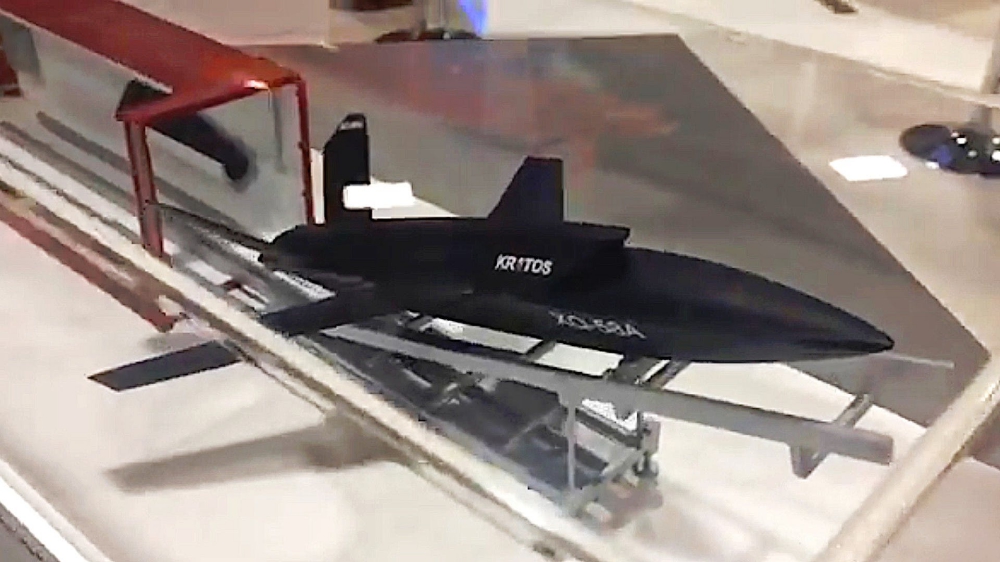Kratos has shown off a launcher for its low-cost XQ-58A Valkyrie unmanned combat air vehicle (UCAV) that fits inside a standard shipping container.
There has been a growing trend toward containerized weapon systems around the world and combining this general concept with the Valkyrie could make these already very exciting drones even more capable of conducting flexible, highly agile, distributed operations.
A model of the “Deployable XQ-58A Valkyrie Launch System” was on display at the Association of the U.S. Army’s main annual convention in Washington, D.C., which opened on Oct. 14, 2019, and came to a close today. Northrop Grumman’s James Drew took a brief video of the model at Kratos’ booth and posted it on Twitter on the last day of the show. The California-headquartered unmanned aircraft company developed the XQ-58A for the U.S Air Force’s Low Cost Attritable Strike Demonstration (LCASD) program, which the Air Force Research Laboratory is managing. The drone took its first flight in March 2019 and conducted a second test sortie two months later. The unmanned aircraft suffered a mishap just last week after completing its third flight.
“Kratos provides ground support equipment that enables agility, remote operations, and deterrence,” a plaque accompanying the model said. “These transportable and deployable solutions offer nondescript launch modules for unmanned aerial/underwater systems and missile defense platforms.”
The Valkyrie Launch System model shows what appears to be a standard ISO shipping container that holds the XQ-58A in a semi-disassembled state with its wings removed and stored on the container walls. Rails on the floor allow the launcher to slide forward out of the container and then angle the drone upward for launch. The display shows that there is also space in the container for other equipment, as well as a fire extinguisher.
If the launch system does fit inside a standardized container, that would open up a world of possible deployment options for the Valkyries. In its present configuration, the XQ-58A is already runway independent given that it takes off from a static launcher and has a parachute recovery system.
The most obvious application of this new containerized system would be to leverage existing military trucks capable of carrying containers, especially those with Palletized Load Systems (PLS) or similar equipment allowing for rapid unloading and offloading. This could allow personnel to quickly set up XQ-58A launch sites, even in very austere locations without any airfield infrastructure, and pack them up just as quickly to avoid enemy counterattacks or otherwise conceal their point of origin.
The limited footprint necessary on the ground could help reduce the need for airfields or other established bases in the future more broadly, as well. The U.S. military as a whole is becoming increasingly concerned about the vulnerability of known, static facilities and their ability to support sustained operations during a major conflict.

Valkyries could potentially conduct the sorties in a semi-autonomous or autonomous mode, reducing the need for direct interaction of any kind from human operators. The Air Force, at present, already envisions the XQ-58A, or an evolved successor, being able to provide a low-cost strike, electronic warfare, or intelligence, surveillance, and reconnaissance platform that can operate individually, in groups of “loyal wingmen” with manned aircraft, or in networked autonomous swarms.
The containerized launch system would also allow rapid movement via other means, including by air, train, or ship. In particular, naval ships, such as amphibious warfare ships with large flight decks, or contractor-operated merchant ships could potentially use the system to launch the drones themselves without the need for other specialized equipment. A single ship could potentially carry dozens of XQ-58As in these self-contained launchers.
The containerized system also means that personnel could launch it rapidly from one location with the intent for another team entirely to recover it at a completely different one. This could squeeze the most out of the drone’s range capabilities by allowing for more optimal route planning, even on short notice. The mobile launcher would also enable personnel to employ the drones in a more flexible manner, in general, and from multiple vectors, which could stretch an opponent’s resources across a broader front and make it more difficult for them to react.
In addition, as Kratos itself has noted, these types of “nondescript launch modules” offer the potential to support discreet or covert operations by using otherwise mundane looking transportation methods, including civilian-style trucks and chartered, contractor-operated ships. This might enable the deployment of more robust unmanned capabilities to support more limited operations, including special operations missions.
These concepts of operation could also benefit from the efforts to make Valkyrie attritable, which is to say cheap enough that it can be employed in riskier situations where chances are lower that it will survive its mission intact. In fact, it is being designed to act basically in a cruise missile, one-way trip mode if required, as well. The containerized launcher and the operating concepts it allows for, as well as the XQ-58A itself, are all well in line with the growing emphasis throughout the U.S. military, as well as in other countries around the world, on distributed warfare.
While we don’t know how much interest the Air Force, or any of Kratos’ other customers, have expressed in this containerized launcher, it will likely be very attractive to the U.S. military, at least, given that it fits its emerging doctrine to an incredible degree.
Source: The Drive

